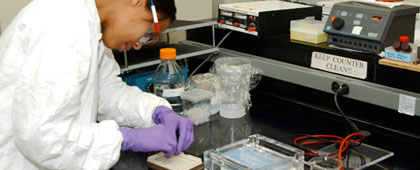 |

A FLEXIBLE DEFENSE
Bioforensics
Tracking the Identity and Origin of Biological Threats
In cases of bioterrorist attack, such as the anthrax cases in late
2001, decision makers and law enforcement need to know quickly what kind
of attack they are facing. Are there any clues hidden in the materials
the attackers used? Is the attacking substance resistant to vaccines or
antibiotics, or does it harbor information leading to the source of the
materials?
Understanding Anthrax
 At Los Alamos National Laboratory intensive research on B. anthracis
over the past several years has led to a wealth of information on the B.
anthracis genome sequence and elite technologies for detecting and identifying
the organism down to its precise DNA fingerprint. At Los Alamos National Laboratory intensive research on B. anthracis
over the past several years has led to a wealth of information on the B.
anthracis genome sequence and elite technologies for detecting and identifying
the organism down to its precise DNA fingerprint.
Sharing the Expertise
Los Alamos technologies have been applied both in the field and in
the laboratory, and some have been transferred to agencies with national
responsibilities for investigating and resolving anthrax diagnoses. Specialty
analysis of the DNA sequence can reveal similarities or differences among
the B. anthracis found in various cases of infection. The degree of relatedness
among different samples can also be determined, in much the same way that
human DNA fingerprinting is used to establish family relationships. |

Tools of the trade
Los Alamos has expertise in a wide range of the technologies needed for detailed forensic analysis of pathogens:
- Amplified Fragment Length Polymorphism analysis (AFLP) has been developed and optimized to analyze B. anthracis samples from naturally occurring anthrax outbreaks around the world.
- Multiple Locus Variable Number of Tandem Repeat analysis (MLVA) gives a very high resolution DNA fingerprint and recognizes a different set of DNA sequences than AFLP. It is somewhat more sensitive to slight genetic variations among different strains of B. anthracis.�
- DNA analysis through a flexible microsphere array that is analyzyed on a flow cytometer platform.�
- The DNA fragment sizing flow cytometer, 100 times faster and 200,000 times more sensitive at analyzing DNA samples than conventional gel electrophoresis. It requires less than two-trillionths of a gram of DNA to perform the analysis.�

|
